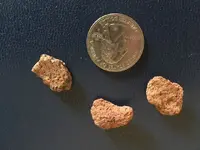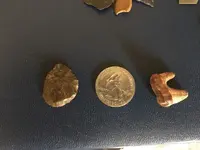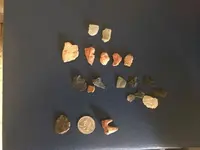jude061
Full Member
- Joined
- Mar 5, 2013
- Messages
- 214
- Reaction score
- 209
- Golden Thread
- 0
- Primary Interest:
- All Treasure Hunting
I found these along the banks of Lake Champlain in Vermont at an area occupied by the Abenaki and English and French Colonists. The water level is about a foot lower than normal. The ceramic looks sand tempered. It was scattered intermittently along the beach and nearby were pieces of chert debitage and what I think might be a chert flake scraper. I also found some 18th and 19th century pottery shards. I think the tooth is a deer molar. The chert next to the quarter has signs of retouching the edge. In the last photo, at the top, the two pieces of quartzite looked like flakes so I kept them, but they're likely just broken rock.









